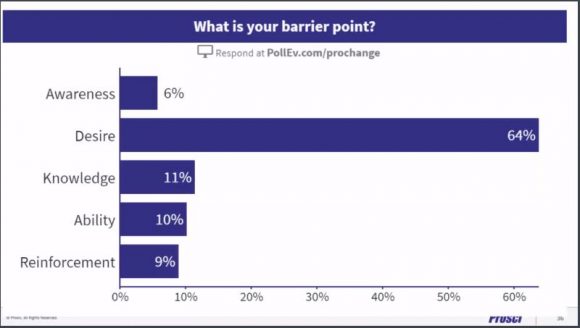The data are abundantly clear. The better we apply change management, the more likely we are to meet project objectives. – ProSci
No surprises there then. In fact, initiatives with excellent change management are 6x more likely to meet objectives than those with poor change management. 5x more likely to stay on or ahead of schedule and 2x more likely to stay on or under budget. That is the intended consequences bit, we have not even touched on the unintended consequences piece.
More recently I read (5.3.19) that around 70% of intended changes do not achieve their goal (Higgs, 2003). So, if change is to be successful and sustained, and if organisations are to continually grow and develop, as required by their changing circumstances, they need to be led by people who know how to embed success and deal with the unknowns and uncertainty that any change brings (Pugh, 1993; Torbert and Associates, 2004; Kotter and Rathgeber, 2006; Carnall, 2009).
Add to that the personal management element of Change Management that effective leaders consider, as part of any change management process. For what it is worth, I reviewed and commented upon Brian Tracy’s best selling “legendary” ‘Eat that frog’ through a personal, education leadership lens and those three posts (part-1, part 2a and part 2b) cross reference here.
Now, I am presuming that if you have found this post, you are in education? More likely to be Secondary than Primary, given my education history and network? An aspiring leader or leader of sorts? Established leader maybe? Welcome one and all. I need your help. Tell me… when and where did you receive guidance or support or training on leading Change – that is Change with a capital ‘C?’ Your comments are very much appreciated.
Education, ever changing
Education will always be a political priority because of the amount of public money expended on it and because it is the key investment in the nation’s future prosperity and wellbeing.
– ASCL Blueprint for a Self-improving-system
For thank reason, education finds itself in perpetual change.
What is more, schools and leadership teams are prone to making changes. Especially new leaders. Even more so – new Head Teachers. Some changes are made by design, some statutory. Some changes are made, then reversed and then made again – I am thinking here of the perennial debates about horizontal and vertical tutor groups, the order of the school day, the pros and cons of centralised and decentralised parent consultation evenings, assessment schedules (what and how many) and what reports should look like? (any other suggestions?). Hence, I am following up on a conversation with Stuart Ridout (former school leader and now Senior Project Manager at Microsoft) and his recommendation for improved organisation management in schools. He signposted Prosci Change Management ADKAR® Model.
It seems mad than some of the great industry tools and practices such as solid project management etc. don’t make it into education.
Stuart Ridout – Senior Project Manager at Microsoft
For what it is worth, I think Stuart is right. He is also uniquely positioned with experience of school leadership and now specialising in business change, Office 365 & enterprise digital transformation. For the record, this is not a plug of EduAdvocacy for Microsoft products. This is just recognising someone else is smarter than you are, exploring their recommendation and reflecting upon that thinking. It just so happens, Stuart works for Microsoft products that enables change. What is more, Stuart is signposting Prosci Change Management Model ADKAR®. After two days reading and note taking, here is my abridged version.
Change Management with ProSci
Prosci operate under five tenets of Change Management:
- We change for a reason.
- Organizational change requires individual change.
- Organizational outcomes are the collective result of individual change.
- Change management is an enabling framework for managing the people side of change.
- We apply change management to realize the benefits and desired outcomes of change.
ADKAR®
Under those tenets, the ADKAR® model supports change.
The Prosci ADKAR® Model is a powerful process-oriented framework that clearly establishes how an individual moves through the change process. Prosci position that change management is both a process and a competency.
There are two important framing statements that I have gleaned from my initial readings:
Change occurs as a process, it is both sequential and cumulative.
Change happens at the individual level. In order for a group or organisation to change, all the individuals within that group or organisation must change. This means that in order to affect change in our organisations, we must first understand how to affect change one person at a time.
Now, though I may not perceive change as always sequential and/or cumulative, I can appreciate why doing so supports change-managers to think through the repeatable set of change management actions. Second, there is definitely value in seeing change management, as changing individuals (counting-in-ones), rather than changing organisations or systems, (an unintended, cumulative reference). Third, when positioned as a competency, change management becomes a set of skills. Skills that enable change and creates a strategic capability for increasing organisational effectiveness. ProSci offers a clean, clear model of change management.
Even access to this clean and clear, uncontextualised framework, could guide many an inexperienced school leader and we have not yet unpacked the ADKAR® model yet.
ADKAR® Model
ADKAR® is an acronym that represents the five tangible and concrete outcomes that people need to achieve for lasting change: awareness, desire, knowledge, ability and reinforcement.
Awareness is all about understanding the need to change. Answering the why is the starting point in achieving any change.
I can not think of any school in which I have worked, where a proposed change has not been contested. Discard whether or not the proposed change valid – change is often dismissed as a ‘waste of time’ or that “the current way of doing things ‘ain’t broke.'”
Awareness is critical and must be achieved before the business or organization can make any meaningful steps towards change.
You will hear “I understand why…”
Desire – represents the willingness to support and engage in a change. See WIIFM.
Desire is reported as often being the most challenging ADKAR® element to achieve. Knowing a change needs to be made is not enough. ProSci offer a free resources that explores each element in more detail, however, I get the sense that desire is even more complex that these resource summarise. For example, awareness is not always crystalised and desire not always elicited. Individual gains may not always realised. .
“I have decided to…”
Certainly, the webinar poll taken during ‘Essentials of ADKAR®’ would underlined this point.

Knowledge of how to change and how to perform / behave in the future state.
Remembering that this model is sequential, knowledge follows the buy-in phase and is part of transition phase. It is fractured into two processes.
- Knowledge on how to change: What to do during the transition – this requires training and education on the skills and behaviors needed to support the change.
- Knowledge on how to perform effectively in the future state: Detailed information on the new roles and responsibilities associated with the change, as well as training and education on how to use new processes, systems and tools.
Take the seismic change of introducing of a new Management Information System to a school. I have encountered a MIS change twice (I would be pleased never to do so again). Context and scope were very different in each case. However, in both scenarios leaders significantly underestimated the cost of change on all three measures; underestimated the adoption times (how long), utilisation (how many) and proficiency (how effective). Even when replacing a failing MIS, where awareness and desire are very high, you can not take for granted that staff know how to change, or how to operate and makes the most of the new MIS.
We were looking to replace “I can not get it to…”, with “I know how to…” Instead we heard “How am I supposed to do my job effectively when…” Simple tasks, became arduous. Bottlenecks started to appear behind expertise. Effectiveness became unevenly distributed. Discretionary effort evaporated over a fire of frustration. Innovation stalled.
Ability to demonstrate skills and behaviours.
Turning knowledge into action. Moving from knowing how to being able to. We are looking for proficiency. Within this framework, building ability is an individualized process.
Proximity (access to experts, coaching, feedback), training (time and focus), culture.
Ability is not equivalent to knowledge. It is not the automatic result of training. After providing knowledge through well-designed training, change leaders must also ensure that employees are given sufficient tools for building their own ability and sufficient time to develop the new skills and behaviors required by the change. ProSci – How to foster ability to implement a change.
Reinforcement is ensuring change will continue.
Meaningful recognition and rewards to sustain change. Measuring and evaluating to ensure the change is sustained. Building momentum during transition to the future state. Creating a culture of successful and sustained change that increases agility for future changes.
Effectiveness of reinforcement is personalised.
I will continue to do this the new way…
Reflections
Exploring ADKAR® has definitely been time well invested. Even if I recognise that I have probably only skimmed the change-management surface – I at least have a framework to work too. My leadership takeaways, change is personal and ‘Ability’ would benefit from greater front-loaded deep-thinking and greater investment of time, training and feedback, and feedforward. If this investment is not available, very carefully assess the true cost-of-change, the reduced pace of adoption, utilization and proficiency.
I may return with Prosci 3-Phase Process – a strategic, step-by-step approach to organizational change management. I have left the Americanism in too.
Certification maybe a stretch too financially far for me, unless Stuart can sneak me in at Microsoft.


